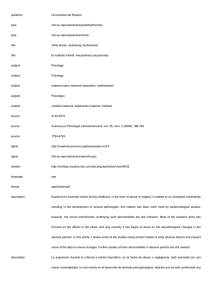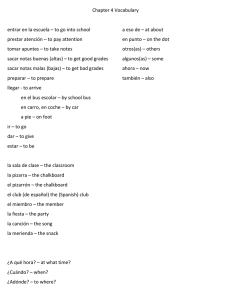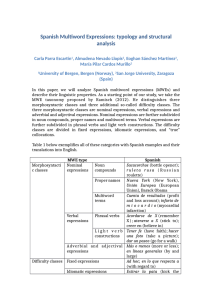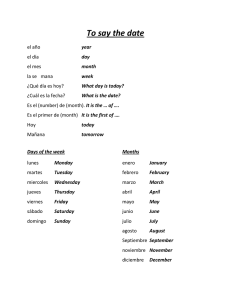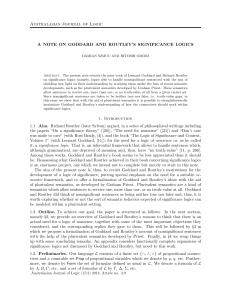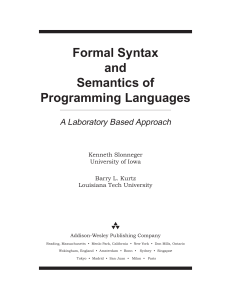una mejor comprensión de nuestra situación en el mundo y de la
Anuncio
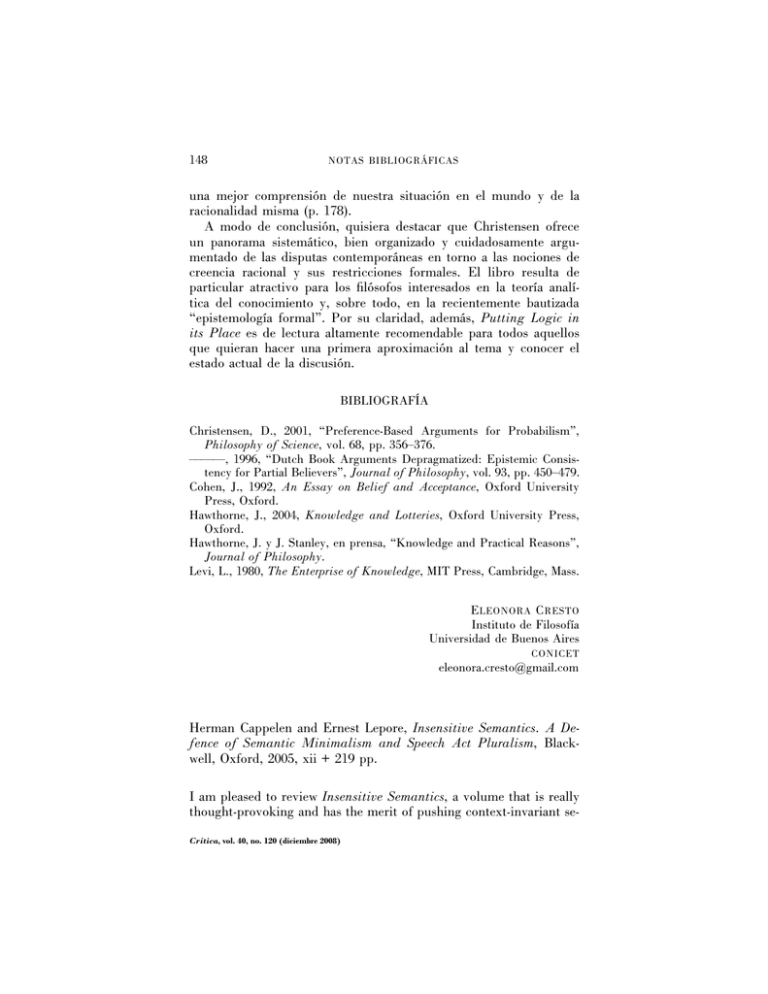
148 NOTAS BIBLIOGRÁFICAS una mejor comprensión de nuestra situación en el mundo y de la racionalidad misma (p. 178). A modo de conclusión, quisiera destacar que Christensen ofrece un panorama sistemático, bien organizado y cuidadosamente argumentado de las disputas contemporáneas en torno a las nociones de creencia racional y sus restricciones formales. El libro resulta de particular atractivo para los filósofos interesados en la teoría analítica del conocimiento y, sobre todo, en la recientemente bautizada “epistemología formal”. Por su claridad, además, Putting Logic in its Place es de lectura altamente recomendable para todos aquellos que quieran hacer una primera aproximación al tema y conocer el estado actual de la discusión. BIBLIOGRAFÍA Christensen, D., 2001, “Preference-Based Arguments for Probabilism”, Philosophy of Science, vol. 68, pp. 356–376. ––——, 1996, “Dutch Book Arguments Depragmatized: Epistemic Consistency for Partial Believers”, Journal of Philosophy, vol. 93, pp. 450–479. Cohen, J., 1992, An Essay on Belief and Acceptance, Oxford University Press, Oxford. Hawthorne, J., 2004, Knowledge and Lotteries, Oxford University Press, Oxford. Hawthorne, J. y J. Stanley, en prensa, “Knowledge and Practical Reasons”, Journal of Philosophy. Levi, L., 1980, The Enterprise of Knowledge, MIT Press, Cambridge, Mass. E LEONORA C RESTO Instituto de Filosofía Universidad de Buenos Aires CONICET eleonora.cresto@gmail.com Herman Cappelen and Ernest Lepore, Insensitive Semantics. A Defence of Semantic Minimalism and Speech Act Pluralism, Blackwell, Oxford, 2005, xii + 219 pp. I am pleased to review Insensitive Semantics, a volume that is really thought-provoking and has the merit of pushing context-invariant seCrítica, vol. 40, no. 120 (diciembre 2008) NOTAS BIBLIOGRÁFICAS 149 mantics after accepting that there is a limited class of (really) contextsensitive expressions. On the one hand, Cappelen and Lepore accept a limited kind of pragmatic intrusion into semantics, in relation to the truth-conditional contribution of (really) context-sensitive expressions; on the other hand, they constrain severely contextual contribution to truth-conditional semantics by saying that the class of really context-sensitive expressions is very small —limited to pronominals (‘he’, ‘she’, etc.), deictic expressions (‘this’, that’, ‘now’) and a few perspectival expressions such as ‘enemy’. Cappelen and Lepore argue against the radical contextualist’s claim that most, if not all, linguistic expressions are context-sensitive and, furthermore, want to prove that the position called ‘moderate contextualism’ easily slides into ‘radical contextualism’. Moderate contextualism is the view that only a number of linguistic expressions, but not all of them, are contextsensitive (and usually contextualists of this type make use of hidden indexicals). Radical contextualism is the view that all linguistic expressions are semantically underdetermined and, thus, acquire full truth-conditional meaning in context. Moderate contextualism easily slides into radical contextualism because the considerations usable for proving that a number of expressions are context-sensitive could generalize to cover all linguistic expressions. One tactic used is to take a perfectly ordinary sentence such as: (1) John went to the gym and argue that, despite appearances, (1) could be claimed to be a context-sensitive expression (which interpretation should we choose? John went into the vicinity of the gym? John went into the gym?, etc.). This is taken as evidence that the arguments by the contextualists generalize too much. (However, it is not clear that all sentences give way to this sort of pragmatic increment; thus there is a bit of exaggeration in the argument.) The volume has a predilection for Kafka-like paradox. The examples used to prove that, once we accept context-sensitivity for, e.g., ‘tall’ (as in ‘tall for a giraffe’), it is not easy to stop at that, as similar arguments could be adopted recursively to prove that the truth-conditions obtained by contextual contribution are themselves in need of further contextualizations. For example, what does ‘tall for a giraffe’ mean? Should we measure the giraffe when it stretches its neck to eat from a tall tree? Should we measure the giraffe when it is alive or dead (we know that dead giraffe shrink)? Should we discount arthritic giraffes? Crítica, vol. 40, no. 120 (diciembre 2008) 150 NOTAS BIBLIOGRÁFICAS Now, while this kind of argument surely shows that the contextualist approaches are not sufficiently fine-grained, it is not clear that it is a terrible blow for proponents of pragmatic intrusion. For it to be a good argument, Cappelen and Lepore ought to prove that such arguments are generated recursively and ad libitum —in other words, there is no point in which one can stop devising similar arguments. A decisive contribution of the book has been to draw demarcation lines between semantics and pragmatics. Intercontextual disquotational indirect reports are taken to be a good test for context-sensitivity, as they block the usage of expressions which are really contextsensitive, e.g., pronominals or deictic elements. Here is an example: (2) John says in C: ‘That is a nice car.’ Alessandro reports in C 0 (where an ugly car is perceptually salient): John said that that is a nice car. Now, it is clear that such uses are forbidden by the practice of indirect reports. On the contrary, when a linguistic expression is context-insensitive, it is possible to abstract away from the contexts of use, as in the following report: (3) In C, John says ‘Mary is ready’. In C 0 , John says ‘Mary is ready’. We can now report: In both C and C 0 John said that Mary was ready. We also expect that uses of predicates which are not sensitive to context could be predicated of a collective description in the scope of an indirect report, as in (4). (4) In C, John says: Mary is ready. In C 0 , Fred says: Mary is ready. We can report: John and Fred said that Mary was ready. Crítica, vol. 40, no. 120 (diciembre 2008) NOTAS BIBLIOGRÁFICAS 151 I think that the tests based on indirect reports are the most solid achievement in the book. This is not to say that these tests should not be discussed and refined further. To make such tests more solid, one should exclude that indirect reports might promote quotational readings, perhaps as a result of loose usages. I hold that in language there is a genuine tension between pure semantics and pragmatics and that it is salutary that a book was written on the tenets of a context-invariant semantics. I find it hard to imagine that there could be a pragmatics, without a semantics. And I personally find claims by Recanati (2004) to the effect that pragmatic modulation is indispensable confusing. Consider Recanati’s example based on ‘open’. Recanati wonders what it is that the following sentences have in common: I opened a window; I opened a book; I opened the cut; I opened the wound; I opened the shirt. He believes they have nothing in common. Now, I think we should distinguish more central cases of opening from less central cases —the less central cases being based pragmatically on the central cases. It is clear to me that the central cases of the meaning of the verb ‘open’ are related to the noun ‘the open’ —thanks to the Longman Dictionary of the English Language for this consideration. Unless we differentiate along these lines, semantics and pragmatics become a nightmare. So, it is good that there should be a book like Insensitive Semantics in which semantics is neatly separated from pragmatics. In my opinion, one weakness of Cappelen and Lepore’s book is that it does not explain semantics properly. The refusal to do so under the dogmatic position that semantics is not metaphysics and metaphysics ought to explain what is, for example, to be tall or to dance, is disconcerting. I think Cappelen and Lepore should take the time to explain things properly and also to show how sophisticated a semantic theory can be. I wonder how the authors could cope with the following example (from the supermarket): A bottle of fruit juice, with the label saying: Crítica, vol. 40, no. 120 (diciembre 2008) 152 NOTAS BIBLIOGRÁFICAS It contains red fruits. We discover it contains fruits that are red either inside or outside. Pomegranates, cherries, red apples, etc. I suppose Cappelen and Lepore would take this example as supporting their theory. In fact, if ‘red fruits’ was a really contextsensitive expression, its truth conditions depending on the kind of fruit being considered, given its plural grammatical morpheme, one would not easily establish which fruit (among many) should provide the criteria for context-sensitivity. If pomegranates are chosen, then ‘red fruits’ would have to mean ‘red for pomegranates’ (red inside); if red apples were considered, then ‘red fruits’ would have to mean ‘red for an apple’ (red outside), etc. However, given the plurality of the expression ‘red fruits’, it is unlikely that any of the fruits in question would provide the criteria for truth-conditions. I thought this example could show that matters are not so simple as contextualists suppose. Summing up, I think this is a great book, one which will stimulate many discussions and which also has a firm grasp of the necessity to mark the boundary between semantics and pragmatics. REFERENCES Capone, Alessandro, 2003, Tra semantica e Pragmatica, Clueb, Bologna. Recanati, François, 2004, Literal Meaning, Cambridge University Press, Cambridge. A LESSANDRO C APONE Department of Philosophy University of Palermo alessandro.capone@unipa.it Crítica, vol. 40, no. 120 (diciembre 2008)
